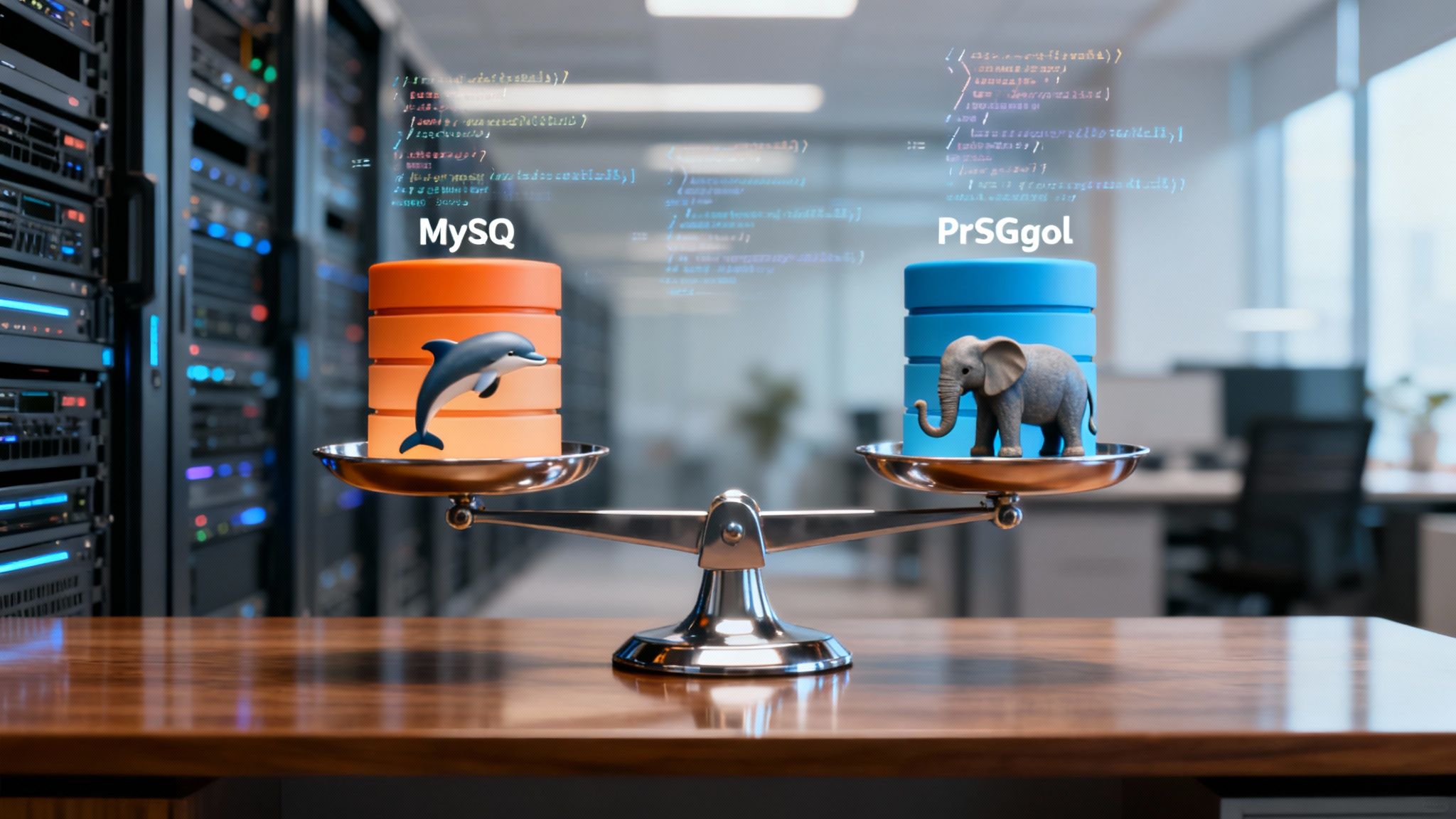Australia
When you're standing at a crossroads between MySQL and PostgreSQL, the "right" choice is rarely a technical absolute. It's about what your project truly needs. For applications where speed, simplicity, and read-heavy performance are king—think most content management systems and e-commerce stores—MySQL often comes out on top.
But if your world involves complex queries, rock-solid data integrity, and serious extensibility—like financial systems or geospatial data platforms—PostgreSQL is the clear winner.
Choosing Your Database: A Quick Comparison
Picking between MySQL and PostgreSQL is one of those early decisions that shapes your application's future. It affects scalability, performance, and the features you can easily implement down the line. Both are phenomenal open-source relational databases (RDBMS), but they come from different philosophical camps, making them better suited for different jobs. Getting this choice right means aligning the database's strengths with your technical and business goals.
For years, MySQL has been the default for many developers, especially in the web world. Its reputation is built on speed in read-heavy situations, a straightforward setup, and a massive community that has solved almost every problem you can imagine.
PostgreSQL, on the other hand, bills itself as "the world's most advanced open-source relational database." It’s known for its strict adherence to SQL standards and a much richer feature set right out of the box. This includes things like native support for complex data types, bulletproof transactional integrity, and incredible power through extensions like PostGIS for geographic data.
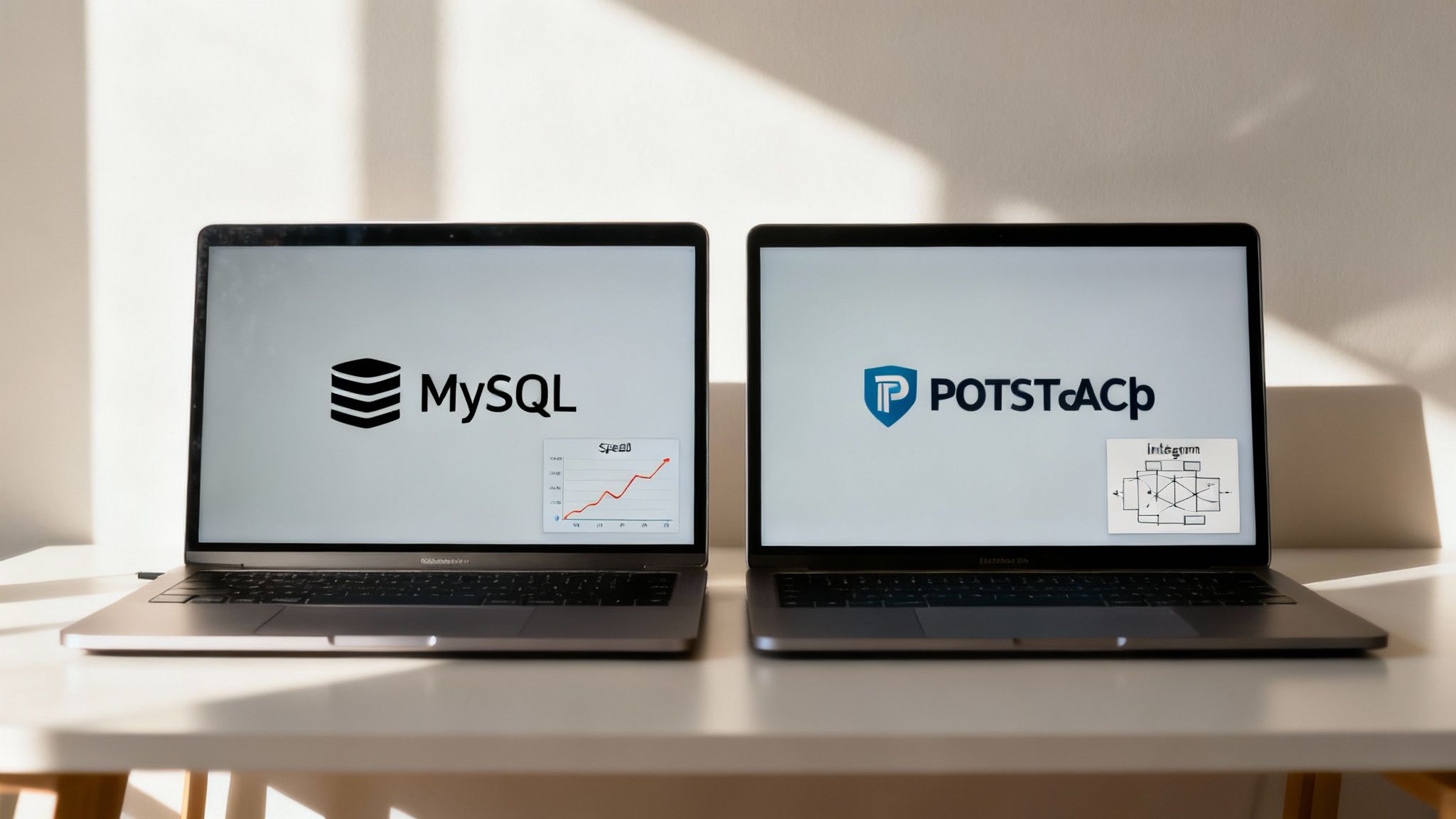
MySQL vs PostgreSQL At a Glance
To cut through the noise, this table lays out the core differences at a high level. It's a great starting point for anyone, especially those just starting an online business who need to choose a tech stack without getting bogged down in the weeds.
| Feature | MySQL | PostgreSQL |
|---|---|---|
| Primary Use Case | Web applications, e-commerce, and read-intensive workloads. | Complex applications, data warehousing, and financial systems. |
| SQL Compliance | More lenient; follows SQL standards but with some non-standard extensions. | Very strict adherence to SQL standards. |
| Data Types | Supports common data types, including robust JSON support. | Supports advanced data types like arrays, hstore, and JSONB. |
| Extensibility | Limited, primarily through its pluggable storage engine architecture. | Highly extensible with custom functions, operators, and extensions like PostGIS. |
| Concurrency | Uses traditional locking mechanisms, optimised for read operations. | Employs Multi-Version Concurrency Control (MVCC) for high concurrency. |
| Community & Ecosystem | Extremely large user base, excellent for web development stacks (e.g., LAMP). | A highly active and growing community focused on advanced features and stability. |
This quick look frames the fundamental trade-offs you'll be making. In the next sections, we'll dive deeper into these points, exploring architecture, performance benchmarks, and real-world scenarios to give you the full picture in the MySQL vs PostgreSQL debate.
Exploring the Core Architectural Differences
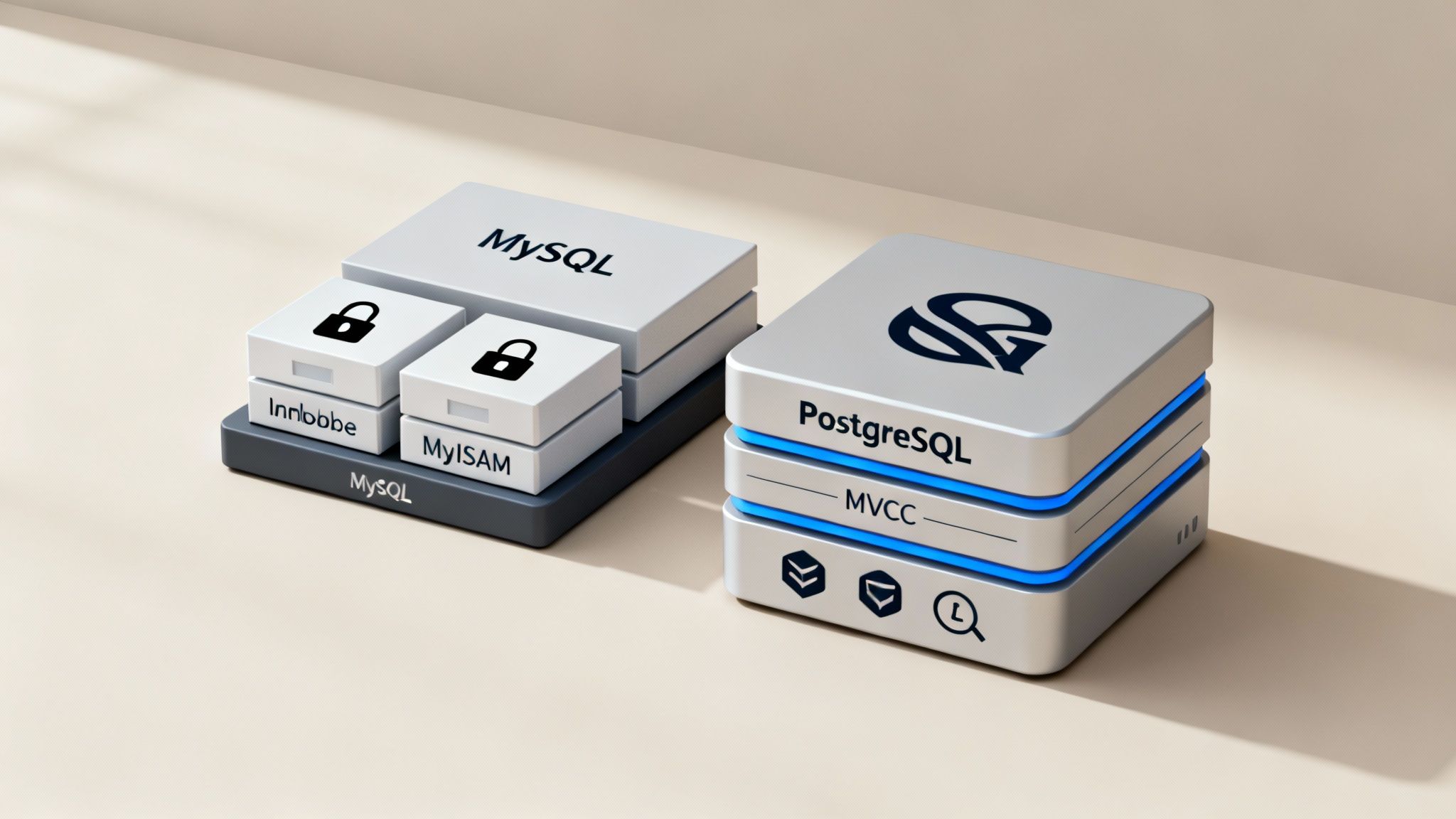
To really get to the bottom of the MySQL vs PostgreSQL debate, we have to look past the feature lists and dig into their foundational architecture. These core design choices dictate everything—how they store data, how they manage multiple operations at once, and ultimately, how they perform under different kinds of pressure. Their fundamental structures are the very source of their biggest strengths and weaknesses.
One of the most telling distinctions is in their storage engine models. MySQL famously uses a pluggable storage engine architecture. Think of it like a car where you can swap out the engine depending on whether you need raw speed or heavy-duty towing power. This gives you the flexibility to pick an engine that’s just right for your application’s specific needs.
For example, the default engine, InnoDB, is a powerful all-rounder, fully ACID-compliant and built for transactional integrity. But in the past, other engines like MyISAM were popular for their blistering speed in read-heavy situations, even though they sacrificed transactional safety to achieve it.
The PostgreSQL Unified Engine Approach
PostgreSQL takes a completely different road. It doesn’t do pluggable engines. Instead, it has a single, highly advanced, and unified storage architecture that has been fine-tuned for decades. This monolithic design is incredibly feature-rich and reliable, capable of handling a massive array of workloads without you ever needing to tinker with the engine itself.
This single-engine approach means that all of PostgreSQL's best features—full ACID compliance, sophisticated indexing, and extensive data type support—are baked right into its core. The result is a system that, from the ground up, prioritises data integrity, strict standards compliance, and extensibility above all else.
Key Takeaway: MySQL gives you flexibility through choice, letting you pick a storage engine tailored to your workload. PostgreSQL delivers a powerful, unified engine designed to master complex, data-heavy tasks straight out of the box.
Handling Simultaneous Operations
Another critical architectural split is how each database deals with concurrency—what happens when lots of users try to read and write data at the same time. This is where the difference between traditional locking and Multi-Version Concurrency Control (MVCC) really comes into play.
MySQL, especially with its older engines, often relied on table-level or row-level locks. While InnoDB has excellent row-level locking, the underlying approach can sometimes cause readers to block writers (and vice versa) in high-traffic environments. This works just fine for applications with far more reads than writes.
In contrast, PostgreSQL was built from day one around a more sophisticated implementation of Multi-Version Concurrency Control (MVCC). Here’s how it creates a much smoother experience for concurrent operations:
- Snapshot Isolation: When a query starts, it sees a "snapshot" of the database at that exact moment. Any changes from other transactions that haven't been committed yet are completely invisible to it.
- Writers Don't Block Readers: Someone writing to a row doesn't stop another person from reading that same row. PostgreSQL just gives the reader the last committed version of the data from its snapshot.
- Readers Don't Block Writers: In the same way, someone reading data doesn't prevent another user from changing it.
This MVCC model is an absolute game-changer for complex environments where many users are reading and writing simultaneously. It dramatically cuts down on lock contention, which is why PostgreSQL is so well-suited for applications demanding high levels of concurrent performance, like financial systems or busy e-commerce sites. This architectural choice is a major reason PostgreSQL often delivers more consistent and predictable performance under heavy, mixed read-write loads.
When you move past simple data storage, the real character of a database shows up in its features and how strictly it follows SQL standards. This is where the choice between MySQL and PostgreSQL often gets decided. A database isn't just a bucket for data; it's the toolbox you'll use to build your application. Picking the one with the right tools is critical for creating something that's not only powerful but also easy to maintain down the line.
PostgreSQL has staked its reputation on being fiercely compliant with SQL standards. That strictness is a huge advantage because it means your queries will behave exactly as you expect, and you can rely on standard functions without having to learn proprietary quirks. It’s a core part of its DNA.
MySQL, on the other hand, often takes a more pragmatic route. While it has become far more compliant over the years, it sometimes bends the rules to favour ease of use or to squeeze out extra performance in specific situations. This can be a good thing, but it occasionally leads to non-standard code that can make a future database migration a real headache.
Advanced Data Types and Structures
One of the clearest dividing lines in the MySQL vs PostgreSQL debate is their support for advanced data types. Right out of the box, PostgreSQL offers a much richer collection, which can radically simplify your application code by handling complex data right inside the database.
PostgreSQL’s native support includes:
- Arrays: Store lists of values, like tags or attributes, in a single field. It's incredibly handy.
- hstore: A key-value store type, giving you schema-less flexibility inside a structured table.
- JSONB: A binary, indexed JSON format that makes querying semi-structured data incredibly fast and efficient.
- Geospatial types: With the industry-standard PostGIS extension, its support for geographic data is second to none.
MySQL might not have the same diversity, but it’s no slouch. Its native JSON data type is highly respected and offers strong storage and querying features. More recent versions have also added excellent support for window functions, closing the gap with PostgreSQL for analytical queries. This makes MySQL perfectly capable for a huge range of applications that need to manage semi-structured data or run complex aggregations.
PostgreSQL's deep support for advanced data types lets developers model complex, real-world information more naturally. This often cuts out the need for clunky workarounds in the application code itself.
Examining Practical Feature Implementation
The differences go deeper than just data types; they show up in how each database implements core functions. Take indexing, for example. PostgreSQL is exceptionally flexible, offering options like GIN (Generalised Inverted Index) for complex types like arrays and JSONB, and GiST (Generalised Search Tree) for indexing geometric data.
MySQL’s indexing, especially with its InnoDB engine, is laser-focused on primary key lookups, which is a big reason it's so fast in many common web application scenarios. Both databases support vital features like Common Table Expressions (CTEs) and window functions, though PostgreSQL’s implementation is generally seen as more complete and closer to the SQL standard. If you want to dive deeper into how MySQL handles real-time data changes for replication or analytics, this guide on Mastering Change Data Capture MySQL for Real-Time Data is an excellent resource.
This distinction is even reflected in local market trends. Here in Australia, for instance, we're seeing a clear rise in PostgreSQL adoption for complex data systems, while MySQL continues to dominate the general web development space. The decision often comes down to whether a project truly needs PostgreSQL's advanced features, like spatial data support or uncompromising transactional integrity—something that's increasingly important for compliance-focused Australian businesses.
Ultimately, PostgreSQL’s richer feature set makes it a powerhouse for applications demanding complex data modelling and airtight integrity. Of course, protecting that data is the top priority; you can read our guide on how to prevent data breaches to make sure your database stays secure. For the vast majority of web applications and services, however, MySQL provides a focused and powerful set of features that are perfectly optimised for the job.
Evaluating Performance Benchmarks and Scalability
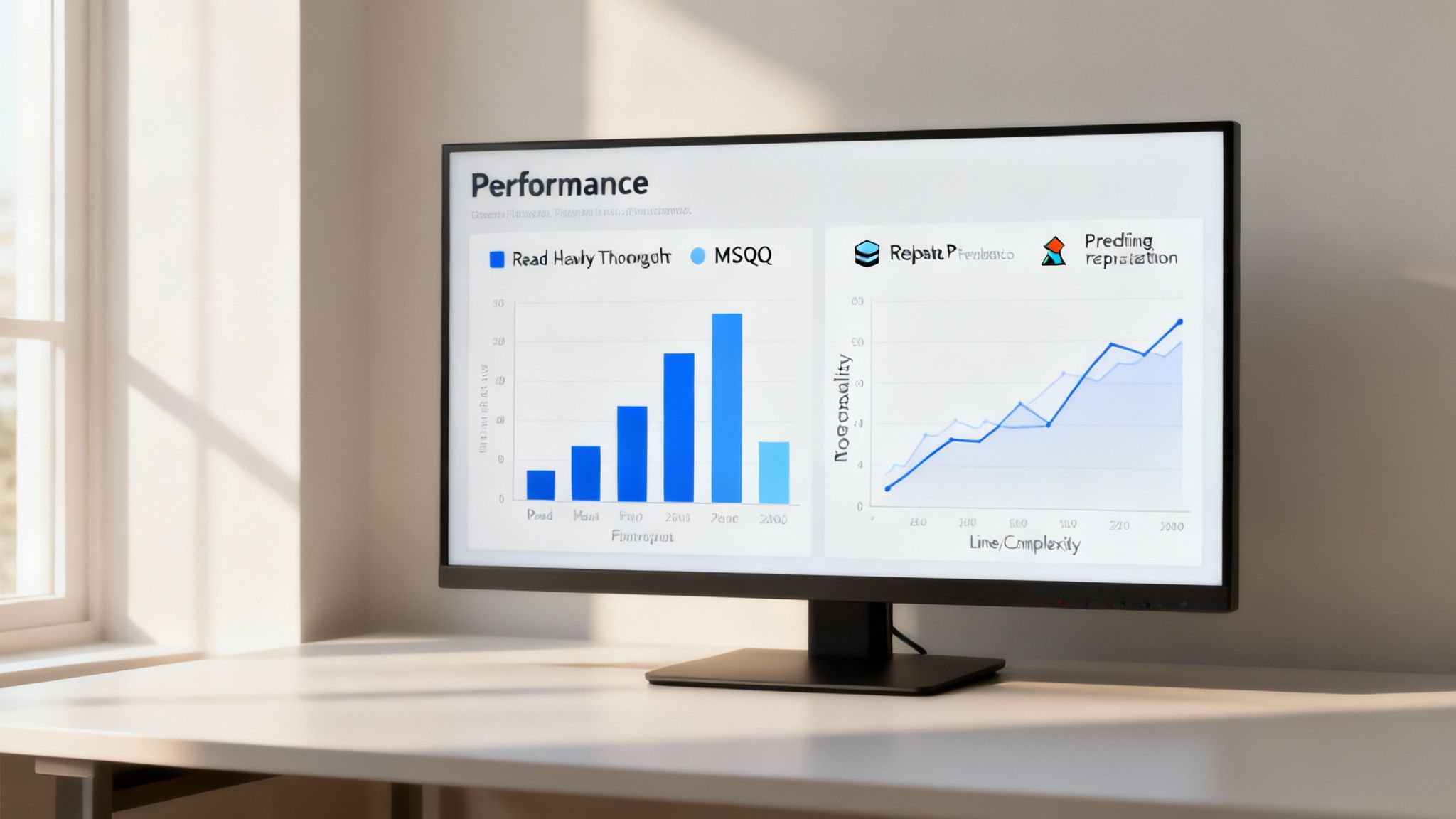
Theoretical differences are interesting, but the real test in the MySQL vs PostgreSQL rivalry happens under pressure. Performance benchmarks show how each database behaves with real-world workloads, giving you the hard data needed to guide your decision. It’s not about finding a universally "faster" database, but understanding which one is faster for your specific needs.
MySQL has built its reputation on blazing-fast performance in read-heavy environments. This is exactly why it became the go-to choice for countless websites, blogs, and e-commerce platforms. Its architecture, especially with the InnoDB storage engine, is highly optimised for quick data retrieval, making it a champion at serving content to many users at once.
PostgreSQL, on the other hand, truly shines when complexity and concurrency ramp up. Its sophisticated query optimiser and Multi-Version Concurrency Control (MVCC) model allow it to handle complex queries and high-volume, mixed read-write operations with remarkable consistency. This makes it a formidable choice for analytical systems and financial applications where data integrity during concurrent transactions is non-negotiable.
Dissecting Workload Performance
The performance gap often boils down to the nature of the tasks at hand. For simple queries and high-traffic websites that mostly read data, MySQL frequently has a slight edge thanks to its lower overhead and focused design.
However, as query complexity grows, PostgreSQL’s advanced query planner often comes up with more efficient execution plans. Liferay’s internal testing revealed that for database-heavy tasks, PostgreSQL consumed significantly less CPU—sometimes as low as one-third of what MySQL needed for similar loads. That efficiency translates directly into more stable response times and better resource management.
In very database-heavy test cases, PostgreSQL was able to constantly consume ~10% of DB server CPU, while MySQL's CPU usage often jumped between 20% and 90%, causing unstable portal response times.
This highlights a key differentiator: MySQL is often faster for simple reads, but PostgreSQL demonstrates superior and more predictable performance under complex, concurrent read-write workloads. This is a critical point for applications expected to handle intricate logic and high user interaction.
The table below breaks down how each database typically performs across different application workloads, giving you a clearer picture of their strengths.
Workload Performance Comparison
| Workload Type | MySQL Performance Profile | PostgreSQL Performance Profile |
|---|---|---|
| Read-Heavy Web Apps | Excellent. Highly optimised for fast reads, making it ideal for content management and e-commerce catalogues. | Very Good. Performs well but can have slightly more overhead on simple queries compared to MySQL. |
| Complex Queries & Analytics | Good. Capable, but the query optimiser can sometimes struggle with very complex joins and aggregations. | Excellent. The advanced query planner excels at finding efficient paths for complex analytical queries. |
| High-Concurrency Transactions | Good. InnoDB offers robust row-level locking, but performance can degrade under heavy mixed read-write loads. | Excellent. MVCC minimises lock contention, providing consistent performance for concurrent read-write operations. |
| Geospatial Data | Limited. Basic support exists, but it cannot compete with the specialised functionality of PostGIS. | Industry Standard. With the PostGIS extension, it offers unparalleled performance and features for geospatial workloads. |
Ultimately, your choice depends entirely on the workload you anticipate. MySQL is built for speed on simpler tasks, while PostgreSQL is engineered for stability and power when things get complicated.
Navigating Scalability and Replication
As your application grows, your database must grow with it. Both MySQL and PostgreSQL offer robust solutions for scaling, but their approaches and flexibility differ. Scalability isn't just about handling more traffic; it's about maintaining performance and reliability as data volume and user loads increase.
MySQL is well-known for its straightforward and highly reliable primary-replica replication. This setup is relatively easy to configure and is the backbone of countless scaled-out web applications. It's a proven model for distributing read traffic across multiple replica servers, taking the load off the primary database.
PostgreSQL offers more advanced and flexible replication options that cater to a wider variety of architectural needs:
- Streaming Replication: This is the most common method, allowing for near-real-time physical replication to one or more standby servers. It's perfect for high availability and read scaling.
- Logical Replication: A more granular approach that replicates data changes based on their logical structure (like rows and tables) rather than their physical block address. This allows for selective replication between different major versions of PostgreSQL or even to other database systems.
This added flexibility in PostgreSQL’s replication models provides more sophisticated options for building resilient, high-availability systems. The choice between MySQL's simplicity and PostgreSQL's advanced options comes down to your long-term scalability strategy and operational requirements.
Analysing Real-World Use Cases
Benchmarks and technical specs are a great starting point, but the real test in the MySQL vs PostgreSQL debate is how they hold up in the wild. The best way to choose is to look at where each database has become an industry standard. An application's context will almost always tell you more about the right database choice than a simple feature list ever could.
MySQL built its reputation on speed, simplicity, and rock-solid reliability, making it the engine of the modern web. Its architecture is perfectly tuned for the read-heavy workloads you see on most online platforms, which is why it’s a favourite for developers everywhere.
This is especially true here in Australia. According to industry data, more than 1,000 Australian companies run on MySQL, from tiny startups to large enterprises pulling in millions in revenue. This incredible market penetration comes down to its open-source roots, massive community, and smooth integration with popular web frameworks. You can dig into more data on MySQL's usage in the Australian market on TheirStack.
Where MySQL Dominates
MySQL is the undisputed champion in any environment where getting things built fast and handling high-volume reads are the top priorities. Its ease of use and enormous ecosystem make it a practical, no-fuss choice for a massive range of applications.
- Content Management Systems (CMS): Platforms like WordPress, Joomla, and Drupal run a huge chunk of the internet, and they almost all rely on MySQL. They need a database that can serve up articles, pages, and user data to thousands of visitors at once without breaking a sweat.
- E-commerce Platforms: Big players like Magento and Shopify (which uses a sharding layer called Vitess on top of MySQL) count on its performance for browsing catalogues and loading product pages. In online retail, the speed of those read operations is absolutely critical to the customer experience.
- Web Applications and SaaS: A huge number of Software-as-a-Service (SaaS) products, social media sites, and online tools get their start—and scale up—on MySQL. Its straightforward primary-replica replication is a well-understood and reliable way to scale out read traffic as you grow.
Where PostgreSQL Excels
PostgreSQL has carved out its own territory in fields where data integrity, complex queries, and extensibility are non-negotiable. It's the database people turn to when a data error would be catastrophic or when the data model itself is just plain complicated.
PostgreSQL's strict adherence to SQL standards and its powerful feature set make it a fortress for mission-critical data. When transactional integrity cannot be compromised, developers overwhelmingly turn to PostgreSQL.
Its real-world applications really show off its strengths in specialised, high-stakes fields:
- Financial and Banking Systems: Fintechs and traditional banks need absolute transactional integrity (full ACID compliance) to stop data from getting corrupted. PostgreSQL’s robust architecture guarantees every transaction is handled correctly, making it a trusted choice for processing payments and managing financial records.
- Geospatial Information Systems (GIS): With its powerful PostGIS extension, PostgreSQL transforms into a full-blown geospatial database. It's used for everything from mapping services and location-based apps to complex geographical analysis—an area where MySQL simply can’t compete.
- Data Warehousing and Analytics: PostgreSQL’s advanced query optimiser, support for window functions, and knack for handling complex joins make it a brilliant choice for data warehousing. It can chew through sophisticated analytical queries, helping businesses find valuable insights in massive datasets. For anyone managing complex data, having a grasp of the fundamentals is a must; check out our introductory guide on Excel for Dummies to build foundational skills.
How to Make the Right Choice for Your Project
So, how do you make the final call between MySQL and PostgreSQL? The answer comes from looking at your project's technical needs and your long-term goals. There's no single "better" database here; the right choice is the one that fits your application's unique demands for speed, data complexity, and future growth.
Instead of chasing a generic recommendation, the decision has to come from a clear-eyed assessment of your specific situation. The real key is to match the database's core strengths to what your project needs most.
A Situational Decision Framework
To help you choose with confidence, ask yourself these critical questions. Your answers will naturally point you toward either MySQL's speed-focused design or PostgreSQL's feature-rich, data integrity-centric architecture.
- What's your primary workload? If your app is read-heavy—think a blog, a content site, or a typical e-commerce store—MySQL's performance optimisations for fast reads give it a clear advantage.
- How complex is your data? For applications that need advanced data types, strict transactional integrity, or complex analytical queries, PostgreSQL’s robust feature set is pretty much indispensable.
- What does your scalability roadmap look like? MySQL offers a straightforward and battle-tested primary-replica replication. PostgreSQL, on the other hand, provides more flexible and advanced options like logical replication for more intricate high-availability setups.
Choosing the right database is a massive piece of the larger architectural puzzle. For a more comprehensive look at this topic, you can learn more about how to choose a technology stack without getting overwhelmed.
Visualising Your Decision Path
This decision tree helps visualise the choice between MySQL and PostgreSQL based on your main project type—whether it's a straightforward web application or a more complex system.
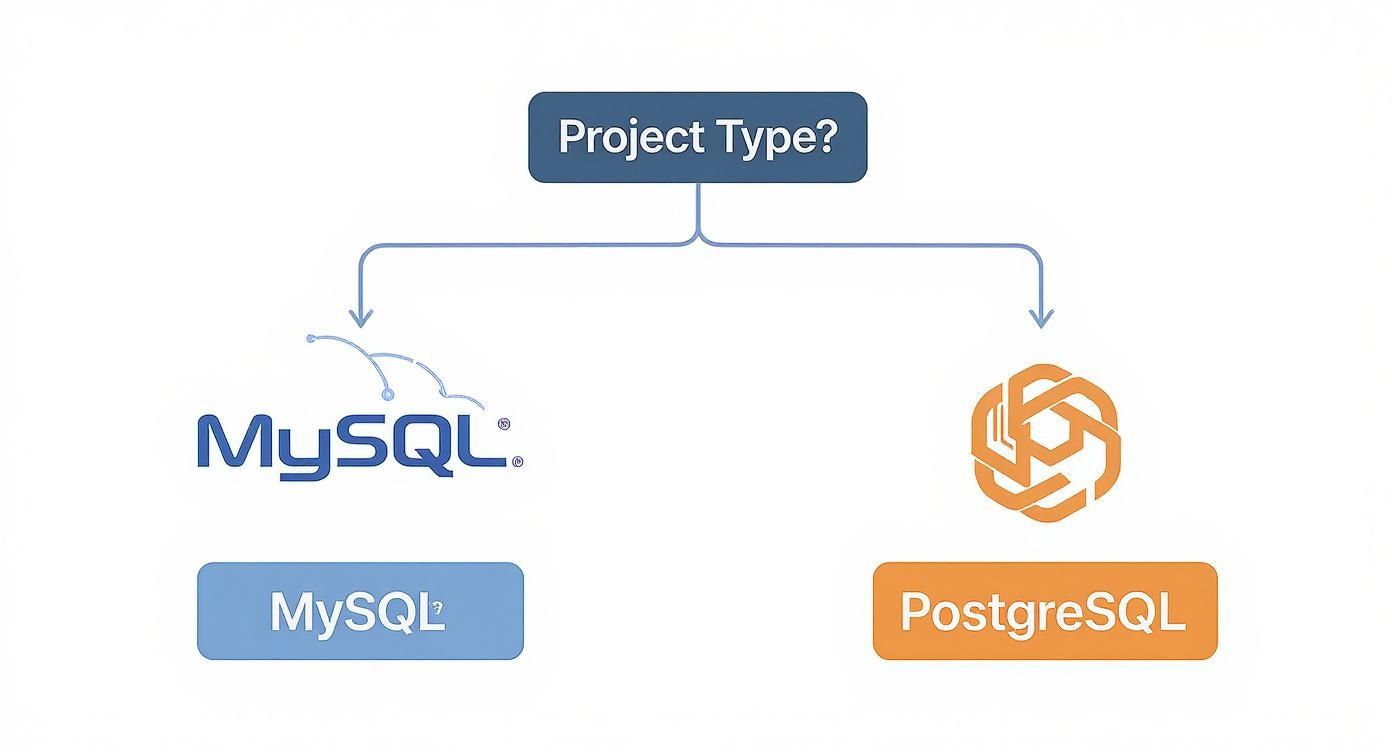
As the infographic shows, the most common path developers take leads to MySQL for streamlined web apps and PostgreSQL for systems that demand greater complexity and rock-solid data integrity.
Final Recommendation: Choose MySQL when your top priorities are rapid development and high performance for read-intensive web applications. Go with PostgreSQL when your project demands absolute data integrity, extensibility, and the power to handle complex, concurrent queries.
This strategic thinking is even reflected in local adoption trends. While MySQL is everywhere, PostgreSQL’s presence in Australia is growing fast, especially in the tech and software sectors. Globally, PostgreSQL holds around 7.7% of the DBMS market, with Australian information technology and software development making up 24% and 16% of its customer base, respectively. This preference is driven by its advanced features that support innovation and robust data management. You can find more insights about PostgreSQL's market presence on enlyft.com.
At the end of the day, both are exceptional open-source databases. What’s non-negotiable is keeping your data secure, no matter which one you choose. You can learn more by checking out our detailed guide on cybersecurity for small businesses. By carefully weighing these points, you can select the database that not only meets your current needs but also supports your project's future.
Frequently Asked Questions
When you're weighing up MySQL and PostgreSQL, the big technical differences are only part of the story. Practical questions about getting started, switching between them, and what it all costs are just as important. Let's clear up some of the most common queries that come up.
Which Is Better for Beginners?
If you're just starting your journey with databases, MySQL is often seen as the more welcoming option. Its setup process is generally a bit more straightforward, and its long-standing popularity, particularly in the web hosting world, means there's a massive amount of tutorials and community help online. When you hit a snag, chances are someone has already solved it, and the answer is a quick search away.
That said, PostgreSQL isn't out of reach for newcomers. Its official documentation is legendary for a reason—it's incredibly thorough, clear, and comprehensive. For anyone who prefers to learn by digging into the details, it's an outstanding resource.
How Difficult Is Migrating from MySQL?
Moving a database from MySQL to PostgreSQL is a serious project that requires careful planning. It's definitely not a simple one-click process, even with tools designed to help automate the data transfer. The real work comes from dealing with the subtle but critical differences between the two systems.
Developers have to manually translate and rewrite variations in key areas:
- Data Types: Some data types in MySQL don’t have a perfect one-to-one match in PostgreSQL, requiring thoughtful conversion.
- SQL Syntax: While both use SQL, specific functions and commands can have different syntax or behave in slightly different ways.
- Stored Procedures: The logic and language used for stored procedures will need to be completely rewritten for PostgreSQL.
The difficulty of the migration scales directly with the size and complexity of your database. A small, simple one might be relatively painless, but a large, intricate system requires a dedicated migration project.
Are Both Databases Truly Free?
Yes, both the MySQL Community Edition and PostgreSQL are genuinely free and open-source. You can download, use, modify, and deploy them without paying any licensing fees, which is a huge reason behind their popularity. Of course, securing any system you choose is vital; understanding what two-factor authentication is and using it where you can is a great first step.
However, for bigger organisations that need enterprise-level support or specialised features, commercial versions are available. Companies like Oracle (for MySQL) and EDB (for PostgreSQL) offer paid editions that include professional support contracts, advanced management tools, and a safety net for mission-critical applications.
At Digital Hub Key, we provide genuine, affordable software licences for all your project needs. Get instant digital delivery for operating systems, productivity tools, and security software at https://digitalhubkey.com.

